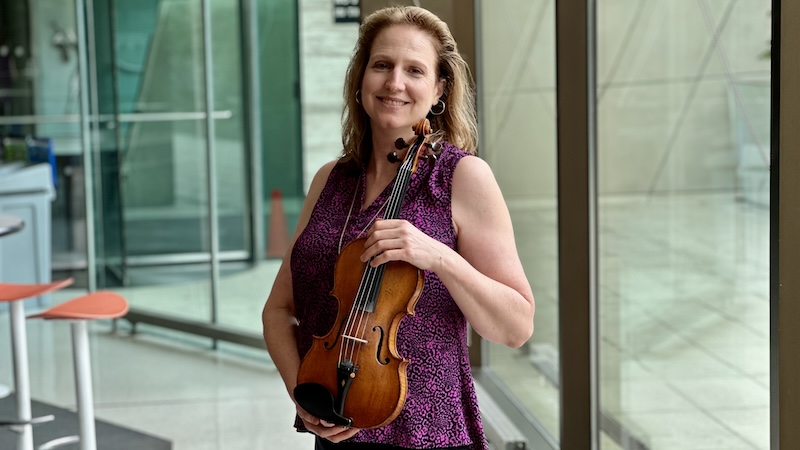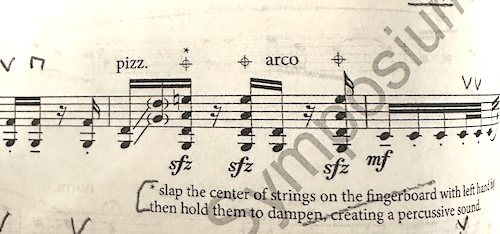Katie Lansdale: Irresistible Violin Repertoire from Around the Globe
It's pretty amazing that single violin can make you feel like you've taken a trip around the world and soaked up myriad cultures, but that is exactly what violinist Katie Lansdale did in her lecture at the Starling-DeLay Symposium on Violin Studies in June. The lecture, which took place over two sessions, was called "It's a Wonderful World: Irresistible Violin Repertoire from Around the Globe."

Violinist Katie Lansdale. Photo by Violinist.com.
Lansdale, a longtime member of the Lions Gate Trio, teaches at the Hartt School at the University of Hartford and the Boston Conservatory at Berklee. She also is a Bach expert who did a wonderful session on Bach pedagogy at a previous Starling-DeLay Symposium.
For her session at this year's symposium, Lansdale explored six pieces for violin from six different cultures: Chinese, African-American, Turkish, Hindustan, Chickasaw and European. Five were written by living composers: Lei Liang, Carlos Simon, Fazil Say, Reena Esmail and Jerod Impichchaachaaha' Tate - with the last piece by the late 20th c. composer Jaroslav Vanecek.

Five composers, L-R: Fazil Say, Lei Liang, Carlos Simon, Jerod Impichchaachaaha' Tate and Reena Esmail.
For each piece, she asked us to first set aside everything, to simply listen and watch as she played the piece live - to just soak it in.
"The agility of the violin is one of its greatest strengths," Lansdale said. "We may not be the loudest or richest sound, but we can take on many different styles."
These were inventive pieces, employing various kinds of melody and harmony as well as extenden violin techniques. After performing each piece, she had us look at the music (with permission from each of composers), try various techniques and play through sections of the pieces.
What a fun session! I can't possibly duplicate what she did in this wonderful combination of live performance and pedagogy lecture, but I'd like to give you information about each piece, as well as summarize what she said, to encourage you to explore these pieces and the composers who wrote them. In this list I'm also including links (click on the highlighted words) where you can purchase the music, as well as some videos of the pieces, where available, for listening reference. Enjoy!
* * *
Lei Liang: "Journey"
Link to purchase the music: Schott Music
Composer Lei Liang was born in China and currently teaches at the University of California, San Diego. One of his parents' dear friends was an expert in Mongolian folk music - which spurred his interest. "Journey" has an ABA form, beginning with a folk tune, then going into what Lansdale called an "asymmetrical romp," and concluding with the folk tune.
My impressions from Lansdale's performance: the piece starts with a similar aesthetic to the Butterfly Lovers Concerto, then goes into a bright passage that is energetic and zippy. Here is where we get the slapping on the wood of the violin, slides, bird-like calls and syncopations. Then it returns to the slow, melodic and beautiful part. Overall it is quite pleasant and peaceful.
Lansdale pointed out that the beginning melody is based on a pentatonic scale - a scale that has no intervals with tension - no tritones, no half-steps. (This might explain why it sounded so placid to me.)

We also enjoyed learning how to do some special effects: the "thwapping and tapping" in measure 32, involving tapping the wood of the violin:

Reference recording:
BELOW: Kate Hatmaker performs "Journey" by Lei Liang.
* * *
Carlos Simon: "Between Worlds"
Link to purchase the music: Bill Holab Music
Some music takes us away from our daily lives - it is meant to be transcendent. But other music is more of a direct reflection of a certain time or place (Lansdale gave the example of Shostakovich). Such is the case with "Between Worlds" by Carlos Simon, who has been Composer-in-Residence at the Kennedy Center since 2021. Simon found inspiration from an exhibit at the Smithsonian American Art Museum that showed the art of Bill Traylor, who was born a slave in Alabama in 1853 and died in 1949. This music reflects that time period that encompasses Traylor's lifetime, which spanned Civil War, Emancipation, Reconstruction, Jim Crow segregation and the Great Migration in America.
Lansdale described the music as having "heavy, weeping melodies" with other passages feeling like "running for your life." To me it sounded bluesy, grieving and expressive. Fast passages felt disoriented - with musical bursts between quiet running notes.
"It's an intense feeling, to play this music," Lansdale said, after she finished. "Art wasn't invented just to reflect the pretty side of being human," Lansdale said, it also reflects the more difficult emotions. So this music contains effects such as intentional "overpressure" of the bow, to create those feelings of brokenness and desperation; as well as tritones and snappy Bartok pizzicato.
Reference recording:
BELOW: Amaryn Olmeda performs "Between Worlds" at the Sphinx Virtuosi Carnegie Hall Concert in October 2022.
* * *
Fazil Say: "Cleopatra"
Link to purchase the music: Schott Music
Fazil Say is a Turkish pianist and composer. "Cleopatra" was written as the compulsory piece for the 2011 International Violin Competition "Henri Marteau" and incorporates Marteau's Caprice No. 10, 'Intermezzo' along with "Arabian sounds in varied rhythmic patterns."
"This piece makes me feel like a one-man band," Lansdale said, as it includes percussion, wailing violin, twangy Bartok pizzicato, col legno (playing with the wood of the bow) and battuto (a collegno involving dropping the stick on the string more vertically).
Lansdale made up a colorful story for herself, when playing the piece: she imagines an old man in an ancient Turkish village, alone in the square. He plays a Turkish folk drum, and he starts tapping on it. Then friends show up and join in - it becomes a total jam session and people start dancing and whirling. Then they drift home, and the man is alone again.
The music fit this quite well! Lansdale started, playing pizzicato using her right thumb (later she explained that this produces a nicer sound, with more fat on the thumb), and then it becomes very busy music - beyond the techniques already mentioned, there is sul ponticello (bowing by the bridge to produce a whistling sound), a melody in octaves, lopsided meters, double-stop trills, a high piercing melody...
To get us in the mood for the "lopsided string" of music in five, she had us sing "Happy Birthday" in 5/8 time:
She also talked about playing "sul ponticello" - that it has to be "so against the bridges that it sounds like a piccolo" - less pitch and more whistle. "Fazil Say is going for all kinds of color," she said, sounds that are raspy, whispering, singing, growling.
Reference recording:
BELOW: Katie Lansdale performs "Cleopatra" by Fazil Say:
* * *
Reena Esmail: "Charukeshi"
Link to purchase the music: Reena Esmail's website
The Los Angeles-based composer Reena Esmail is a graduate of The Juilliard School as well as Yale University, and her style often fuses Hindustani with classical music. "Charukeshi" is a movement from her work "Darshan," written for her husband Vijay Gupta, and in Esmail's words "it explores grief, in its many facets and forms."
"It is sad and of comfort, with silvery sounds," Lansdale said, "and at the end we get to go to another place."
In Hindi "Darshan" means "seeing," as in seeing the divine, and this movement uses the Charukeshi raga, thus its name.
Listening to Lansdale perform the work, I noticed the harmonics, Indian harmonies, lots of string crossings, and a starry, other-worldly feel.
In performing the piece, Lansdale said that "we get to connect notes, spending more time in the space between notes than on the notes." Or in other words: more time and focus on the journey, rather than the destination. Let's use the "Happy Birthday" example again!
Some thoughts for performance: the sul ponticello harmonics are like the whisper of a ghost, so commit to the ponticello - "you don't want it to sound like a mistake." Instead you want to get to the evocative nature of that technique: get so close to the bridge that you get a whistle.
She called the first note a "melancholy flip-back," the way the bow starts with notes on the G string, circles up through all four strings and back. "How much time can you spend, in between notes?" she said, adding that it should be "super sensuous."
Reference recording:
BELOW: Vijay Gupta performs "Charukeshi" from "Darshan" by Reena Esmail.
* * *
Jerod Impichchaachaaha' Tate: Shawi' Impanompa' (Raccoon Talk)
Link to purchase the music: Click here for program notes; to purchase or rent the music E-mail Trudy Chan with your request.
Oklahoma composer Jerod Impichchaachaaha' Tate is a citizen of the Chickasaw Nation, and his inspiration for Shawi' Impanompa' is the raccoon - the "chattery troublemaker" that also stands as a symbol for his family's American Indian tribal clan. It is a piece that he actually wrote for Lansdale.
Tate incorporates an ancient Chickasaw Raccoon Song, stating the theme at the beginning in harmonics and returning to it in various guises throughout. In the video below, Lansdale describes a few treatments of the raccoon theme: a "royal, rich treatment of the theme"; a spooky version depicting the spirits of the raccoons; a "clever section" where the raccoons are getting a little snarky; and finally a "frenzied violinist version: of the raccoon theme:
Tate also designed the music for audience participation, and Lansdale instructed us to participate in three ways:
This piece had a lot of fun effects and was quite involving. It would certainly work well for an educational concert, or any concert in which you really want to engage the audience. You have to be willing to be a bit theatrical! There is a good deal of fast passagework, open strings, exuberant noise and fun meters like 7/8. Very catchy!
Reference recording:
BELOW: Katie Lansdale performs Shawi' Impanompa' (Raccoon Talk) by Jerod Impichchaachaaha Tate. Note: the piece is written for solo violin and audience participation; in this recording, there is no audience.
* * *
Jaroslav Vanecek: Spanish Rhapsody
Link to purchase the music: Presto Music
The last piece Lansdale introduced was not by a living composer - this was more of a "forgotten" European piece by a lesser-known composer. Jaroslav Vanecek (1920-2011) was a Czech violinist and composer, who moved to Ireland and then London, where he taught at the Royal College of Music. The piece he wrote was not Czech nor Irish nor English, but a "Spanish Rhapsody."
"It's incredibly fun to play this piece." Lansdale said. What makes it so fun? It's complicated, exciting and unrelenting, full of snappy rhythms and challenging techniques like ricochet, left-hand pizzicato, double stops, octaves, pizzicato chords, col legno, glissandi and more.
It begins with a tango rhythm and goes on to explore various dances - "tempo di passo doble" and a "tempo di rumba," borrowing some tricks from plucked-string instruments.
"I learned a lot about the guitar and mandolin, playing this piece," Lansdale said.
Reference recording: I was not able to find a recording of this piece (chime in, if you have one!) But Lansdale played it beautifully, and it's certainly a piece worth bringing to life, for anyone up to the challenge!
* * *
In conclusion, Lansdale emphasized that it is up to musicians to champion the work of composers, to bring out forgotten pieces and bring forth new ones.
The old classics may be our "primary river" but "under that river there is a new current."
It is the musicians who open the door for the new music, so don't be shy about contacting composers and seeking out their compositions.
"Composers are incredibly thrilled when people want to play their music," Lansdale said. When it comes to their compositions, "they don't have a life, unless we put them forward."
You might also like:
- Interview: Chickasaw Composer Jerod Tate's 'MoonStrike' Hits Carnegie Hall
- Vijay Gupta Plays 'When the Violin,' by Reena Esmail
- A Conversation with Violinist Itzhak Perlman
- All stories from Starling-DeLay Symposium on Violin Studies at Juilliard
* * *
Enjoying Violinist.com? Click here to sign up for our free, bi-weekly email newsletter. And if you've already signed up, please invite your friends! Thank you.
Replies
This article has been archived and is no longer accepting comments.
Violinist.com is made possible by...
Dimitri Musafia, Master Maker of Violin and Viola Cases
International Violin Competition of Indianapolis
Johnson String Instrument/Carriage House Violins
Subscribe
Laurie's Books
Discover the best of Violinist.com in these collections of editor Laurie Niles' exclusive interviews.

Violinist.com Interviews Volume 1, with introduction by Hilary Hahn

Violinist.com Interviews Volume 2, with introduction by Rachel Barton Pine








July 20, 2025 at 07:38 PM · These “new” composers certainly display talent. Raccoon Talk, in particular , is one of the most challenging and interesting pieces I’ve ever heard. Katie has carved outa niche for herself as a brilliant violinist.